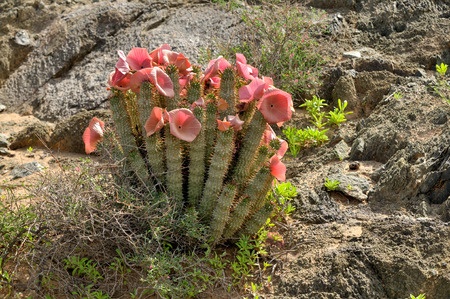
Hoodia created a great deal of excitement when it was found to have appetite suppressant opportunities. Weight loss is a health necessity for many people around the globe, and so any natural supplement which might reduce a craving for food would have global impact.
Hoodia, (Family: Apocynaceae) is a genus of 13 succulents found in arid regions of Southern Africa. The most important is Hoodia gordonii (Masson) Sweet ex Decne. The tribes people, the San, Topnaar and Khoikhoi reportedly chewed Hoodia to suppress their thirst but this did not suggest to early observers, a reduction in appetite. In fact, Hoodia was eaten to reduce the impact of cold, abdominal cramps and even reduce diabetes (Rader et al., 2007). It wasn’t long before dozens of products appeared, not all of them reputable. Given its succulent nature and being slow-growing, demand could not be met and so the potential for adulteration was high.
Since the initial discovery, the actives have been exhaustively researched. Compounds to be isolated include the 11 hoodigosides A to K which are the oxypregnane glycosides (Avula et al., 2007; Pawar et al., 2007a), the calogenin glycosides (Pawar et al., 2007b) . Great strides have been made to minimise fraud by fingerprinting the species and identifying the critical actives (Avula et al., 2008; Rumalla et al., 2008). A very good review details the current state of knowledge surrounding this plant and its commercialisation (Vermaak, 2011) and in the treatment of obesity (Pereira et al., 2010).
Clearly this post is very short given the wealth of information out there on the plants. I’d be interested to know if anyone has ever used the supplement and whether it has helped them with weight issues.
References
Avula, B, Wang Y, Pawar RS, Shukla YJ, Khan, I.A. (2007). Chemical fingerprinting of Hoodia species and related genera: chemical analysis of oxypregnane glycosides using high-performance liquid chromatography with UV detection in Hoodia gordonii. J. AOAC Int., 90(6): pp. 1526-1531.
Avula, B, Wang Y, Pawar RS, Shukla YJ, Smillie Tj, Khan IA (2008). A rapid method for chemical fingerprint analysis of Hoodia species, related genera and dietary supplements using UPLC-UV-MS. J.Pharm. Bomed. Anal., 48 pp. 722-731
Pawar, R.S., Shukla, Y.J., Khan, I.A. (2007a) New calogenin glycosides from Hoodia gordonii. Steroids 72 (13) pp. 881–891.
Pawar, R.S., Shukla, Y.J., Khan, S.I., Avula, B., Khan IA. (2007b) New oxypregnane glycosides from appetite suppressant herbal supplement Hoodia gordonii. Steroids 72 (6–7) pp. 524–534.
Pereira, C.A., Pereira, L.L.S., Corrêa, A.D. (2010) Hoodia gordonii in the treatment of obesity: A review. J. Medicinal Plants Res., 4(22) pp. 2305-2312
Rader JI, Delmonte P, Trucksess MW. (2007) Recent studies on selected botanical dietary supplement ingredients. Anal. Bioanal. Chem. 389(1) pp. 27–35.
Rumalla, C.S., Avula, B., Shukla, Y.J., Wang, Y-H., Pawar, R.S., Smillie, T.J., Khan, I.A. (2008) Chemical fingerprint of Hoodia species, dietary supplements, and related genera by using HPTLC. J. Separation Sci., 31(22) pp. 3959-3964
Van Heerden, F.R. (2008) Hoodia gordonii: A natural appetite suppressant. J. Ethnopharmacology. 119 (3) pp. 434-437
Vermaak, I., Hamman, J.H., Viljoen, A.M. (2011) Hoodia gordonii: An Up-to-Date Review of a Commercially Important Anti-Obesity Plant. Planta Med. 77 pp. 1149-1160



Leave a Reply